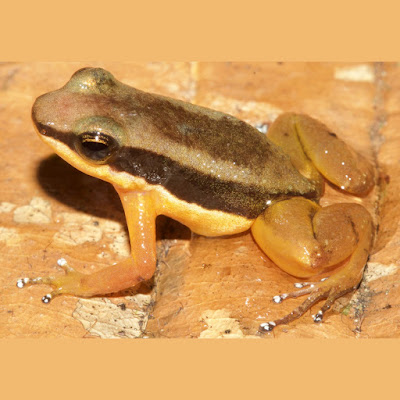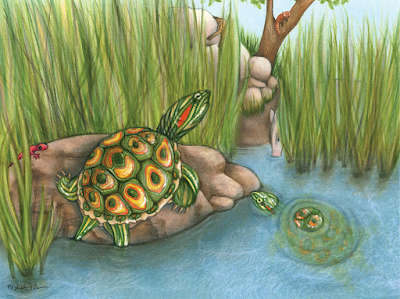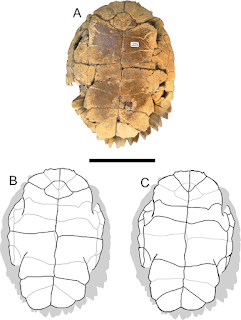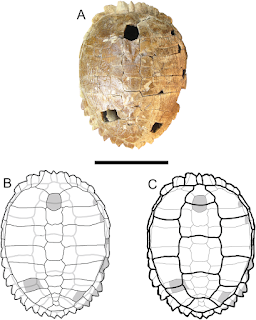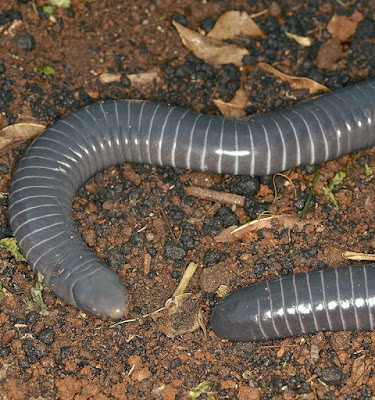[Most Recent Entries] [Calendar View]
Monday, February 26th, 2018
| Time | Event | ||
| 3:01a | [Herpetology • 2018] Allobates juami • A New Species of Nurse-frog (Aromobatidae, Allobates) from the Juami River Basin, northwestern Brazilian Amazonia Abstract We describe a new species of nurse-frog (Aromobatidae, Allobates) from northwestern Brazilian Amazon. Allobates juami sp. nov. is distinguished from similar congeneric species by the combination of the following characters: body-size range (snout-to-vent length 17.5–18.5 mm), lack of dark pigments on ventral surfaces of male specimens, dorsal color pattern (predominantly solid dark brown, but conspicuously light brown over snout and urostyle regions), presence of conspicuous pale dorsolateral and ventrolateral stripes, and presence of a diffuse pale paracloacal mark. The advertisement call of the new species lasts 2.5–5.1 s, contains 60–73 short notes (trills), and is emitted at an average rate of 13 notes per second within trills. Duration of silent intervals between notes ranges between 0.020–0.050 s, and the peak frequency of notes ranges from 4.59 to 5.47 kHz. The new species is currently known only from the type locality at Estação Ecológica Juami-Japurá (~ 87 m a.s.l.). Keywords: Amphibia, advertisement calls, Amazonia, conservation units, Dendrobatoidea, Japurá River Pedro Ivo Simões, Giussepe Gagliardi-Urrutia, Fernando J.M. Rojas-Runjaic and Santiago Castroviejo-Fisher. 2018. A New Species of Nurse-frog (Aromobatidae, Allobates) from the Juami River Basin, northwestern Brazilian Amazonia. Zootaxa. 4387(1); 109–133. DOI: 10.11646/zootaxa.4387.1.5 | ||
| 11:01a | [Paleontology • 2018] Trachemys haugrudi • A New Slider Turtle (Testudines: Emydidae: Deirochelyinae) from the late Hemphillian (late Miocene/early Pliocene) of eastern Tennessee and the Evolution of the Deirochelyines
Abstract Trachemys (Testudines: Emydidae) represents one of the most well-known turtle genera today. The evolution of Trachemys, while being heavily documented with fossil representatives, is not well understood. Numerous fossils from the late Hemphillian Gray Fossil Site (GFS) in northeastern Tennessee help to elucidate its evolution. The fossil Trachemys at the GFS represent a new species. The new taxon, Trachemys haugrudi, is described, and currently represents the most thoroughly described fossil emydid species known. A phylogenetic analysis, including 31 species, focusing on the subfamily Deirochelyinae is performed that includes the new fossil species, along with numerous other modern and fossil deirochelyine species, representing the first phylogenetic analysis published that includes several fossil deirochelyines. The phylogenetic analysis, utilizing morphological evidence, provides monophyletic clades of all modern deirochelyines, including Chrysemys, Deirochelys, Pseudemys, Malaclemys, Graptemys, and Trachemys. A strict consensus tree finds the recently described fossil species Graptemys kerneri to be part of a clade of Graptemys + Malaclemys. Three fossil taxa, including one previously referred to Pseudemys (Pseudemys caelata) and two to Deirochelys (Deirochelys carri and Deirochelys floridana) are found to form a clade with modern Deirochelys reticularia reticularia, with D. floridana sister to the other members of the clade. Chrysemys is found to be part of a basal polytomy with Deirochelys in relation to other deirochelyine taxa. Two fossil taxa previously referred to Chrysemys (Chrysemys timida and Chrysemys williamsi) form a paraphyly with the modern Chrysemys picta picta and Deirochelys, and may be referable to distinct genera. Additionally, fossil taxa previously attributed to Trachemys (Trachemys hillii, Trachemys idahoensis, Trachemys inflata, and Trachemys platymarginata) and T. haugrudi are found to form a clade separate from clades of northern and southern Trachemys species, potentially suggesting a distinct lineage of Trachemys with no modern survivors. Hypotheses of phylogenetic relationships mostly agree between the present study and previous ones, although the inclusion of fossil taxa provides further clues to the evolution of parts of the Deirochelyinae. The inclusion of more fossil taxa and characters may help resolve the placement of some taxa, and further elucidate the evolution of these New World turtles. Figure 3: Trachemys haugrudi, holotype shell (ETMNH–8549). (A) Dorsal view of carapace; (B) line drawing of carapace in dorsal view, with bones outlined in black and scutes outlined in gray; and (C) with scutes outlined in black and bones outlined in gray. Missing portions are shaded in gray. Scale bar is 10 cm. Figure 4: Trachemys haugrudi, holotype shell (ETMNH–8549). (A) Ventral view of plastron; (B) line drawing of plastron in dorsal view, with bones outlined in black and scutes outlined in gray; and (C) with scutes outlined in black and bones outlined in gray. Scale bar is 10 cm. Systematic Paleontology Class Reptilia Laurenti, 1768 Order Testudines Linnaeus, 1758 Suborder Cryptodira Cope, 1868 Superfamily Testudinoidea sensu Gaffney & Meylan, 1988 Family Emydidae Bell, 1825 Trachemys Agassiz, 1857 Trachemys haugrudi n. sp. Type horizon and age: Late Miocene–early Pliocene (late Hemphillian LMA, 7.0–4.5 Ma). This range means the fossil locality, and T. haugrudi, lies somewhere within Hh3–Hh4 (see Tedford et al., 2004 for discussion of substages). Etymology: The specific name honors Shawn Haugrud, preparator at the GFS who spent countless hours working on many of the specimens cited within and who helped piece this ancient turtle back together. Diagnosis: Trachemys haugrudi is placed in the Emydidae due to the absence of musk ducts, inframarginals reduced to two, normal hexagonal neurals 2–8 (also occurs in a few batagurids (=geoemydids); e.g., Mauremys), and costal-inguinal buttress confined to C5. It is placed in the Deirochelyinae due to distinct lack of pectoral overlap of the entoplastron and lack of a hingable plastral lobe with ligamentous bridge connection (also present in some emydines). Diagnosed as a member of the genus Trachemys by features discussed by Seidel & Jackson (1990), including the combination of: a posteriorly strongly serrated oval carapace; a vertebral keel; low longitudinal ridges (mainly on pleurals (and costals)); alternating seams of the vertebral and pleural scutes that do not align; ...... Steven E. Jasinski. 2018. A New Slider Turtle (Testudines: Emydidae: Deirochelyinae: Trachemys) from the late Hemphillian (late Miocene/early Pliocene) of eastern Tennessee and the Evolution of the Deirochelyines. PeerJ. 6:e4338. DOI: 10.7717/peerj.4338 | ||
| 5:55p | [Herpetology • 2018] Skin Gland Concentrations Adapted to Different Evolutionary Pressures in the Head and Posterior Regions of the Caecilian Siphonops annulatus
Abstract Amphibian skin is rich in mucous glands and poison glands, secreting substances important for gas exchange and playing a fundamental role in chemical defense against predators and microorganisms. In the caecilian Siphonops annulatus (Mikan, 1920) we observed a concentration of enlarged mucous glands in the head region. In the posterior region of the body a similar concentration is made up of enlarged poison glands. These accumulations of glands structurally resemble the macroglands previously reported in anurans and salamanders. The skin glands in these regions are each surrounded by collagen walls forming a honeycomb-like structure. The collagen network in the head region firmly attaches to tiny pits in the bones of the skull. The two extremities of the body produce different secretions, containing exclusive molecules. Considering the fossorial lifestyle of caecilians, it seems evident that the secretions of the head and caudal region serve different functions. The anterior macrogland of mucous glands, rich in mucous/lipid secretion, in conjunction with the funnel-shaped head, may act to lubricate the body and penetrate the soil, thus facilitating locomotion underground. The blunt posterior end bearing an internalized macrogland of poison glands in the dermis may act in chemical defense and/or by blocking invasion of tunnels. Carlos Jared, Pedro Luiz Mailho-Fontana, Rafael Marques-Porto, Juliana Mozer Sciani, Daniel Carvalho Pimenta, Edmund D. Brodie Jr. and Marta Maria Antoniazzi. 2018. Skin Gland Concentrations Adapted to Different Evolutionary Pressures in the Head and Posterior Regions of the Caecilian Siphonops annulatus. Scientific Reports. 8, Article number: 3576. DOI: 10.1038/s41598-018-22005-5 Playing both ends: Amphibian adapted to varied evolutionary pressures phy.so/438499863 via @physorg_com |
| << Previous Day |
2018/02/26 [Calendar] |
Next Day >> |
